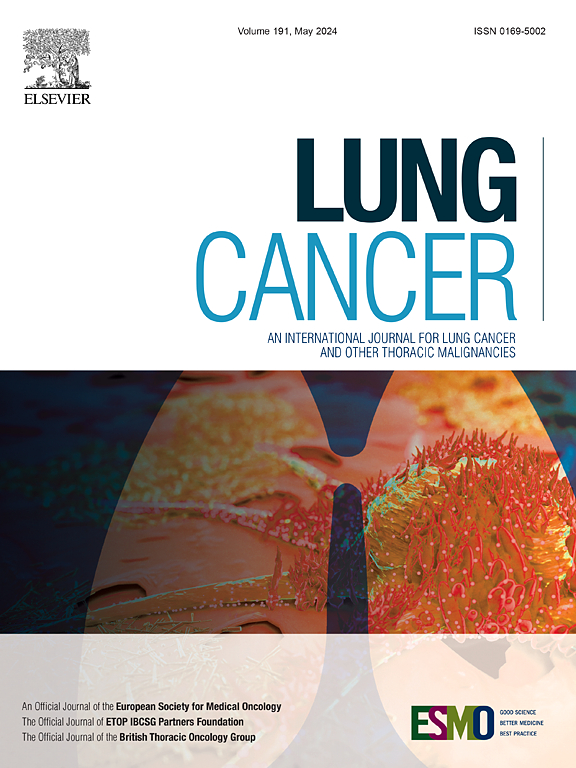胸腺神经内分泌肿瘤谱系特异性转录因子图谱
IF 4.4
2区 医学
Q1 ONCOLOGY
引用次数: 0
摘要
胸腺神经内分泌肿瘤(TNETs)是一种罕见的恶性肿瘤,其特点是具有侵袭性的临床行为和有限的治疗选择。在小细胞肺癌(SCLC)中,已经提出了基于谱系定义转录因子(tf)表达的分子亚型-ASCL1, NEUROD1, POU2F3和yap1。然而,TNETs的TF前景仍然不明确。鉴于跨器官神经内分泌肿瘤的病理相似性,我们旨在研究SCLC中基于tf的分类系统是否适用于TNETs。方法回顾性分析16例经病理证实的tnets,包括大细胞神经内分泌癌(LCNEC)、胸腺小细胞癌(TSCC)、非典型类癌(AC)和典型类癌(TC)。免疫组化评价经典神经内分泌(NE)标志物(synaptophysin, chromogranin A, CD56)和tf (ASCL1, NEUROD1, POU2F3, YAP1)。计算h评分,并根据tf表达谱对肿瘤进行分类。结果synaptophysin在所有病例中均有强表达,而嗜铬粒蛋白A和CD56在LCNEC和TSCC中表达不同,表达水平较低。与LCNEC和TSCC相比,类癌的NE综合评分明显更高。对于tf, ASCL1在93.8%的病例中表达,而NEUROD1和POU2F3很少或不表达。YAP1的表达仅限于LCNEC病例,所有LCNEC病例均同时表达ASCL1和YAP1。根据h -评分将TNETs分为3个亚组:(1)ASCL1阳性/YAP1阴性(n = 12,75 %), (2) ASCL1/YAP1双阳性(n = 3,19 %),(3)双阴性(n = 1,6 %)。结论本研究揭示了TNETs的分子异质性。值得注意的是,ASCL1和YAP1共表达是所有LCNEC病例的特征,在高级别TNETs中形成了独特的TF景观。本文章由计算机程序翻译,如有差异,请以英文原文为准。
Lineage-specific transcription factor landscape of thymic neuroendocrine tumors
Introduction
Thymic neuroendocrine tumors (TNETs) are rare malignancies characterized by aggressive clinical behavior and limited therapeutic options. In small cell lung cancer (SCLC), molecular subtypes based on the expression of lineage-defining transcription factors (TFs)—ASCL1, NEUROD1, POU2F3, and YAP1—have been proposed. However, the TF landscape of TNETs remains poorly defined. Given the pathological similarities among neuroendocrine tumors across organs, we aimed to investigate whether the TF-based classification system used in SCLC is applicable to TNETs.
Methods
Sixteen pathologically confirmed TNETs—including large cell neuroendocrine carcinoma (LCNEC), thymic small cell carcinoma (TSCC), atypical carcinoid (AC), and typical carcinoid (TC)—were retrospectively analyzed. Immunohistochemistry was performed to evaluate classical neuroendocrine (NE) markers (synaptophysin, chromogranin A, CD56) and TFs (ASCL1, NEUROD1, POU2F3, YAP1). H-scores were calculated, and tumors were categorized according to TFs expression profiles.
Results
Synaptophysin was strongly expressed in all cases, while chromogranin A and CD56 showed variable expression, with reduced levels in LCNEC and TSCC. The combined NE score was significantly higher in carcinoid tumors compared to LCNEC and TSCC. For TFs, ASCL1 expression was observed in 93.8 % of cases, whereas NEUROD1 and POU2F3 were rarely or not expressed. YAP1 expression was confined to LCNEC cases, all of which co-expressed ASCL1 and YAP1. Based on H-scores, TNETs were classified into three subgroups: (1) ASCL1-positive/YAP1-negative (n = 12, 75 %), (2) ASCL1/YAP1 double-positive (n = 3, 19 %), and (3) double-negative (n = 1, 6 %).
Conclusion
This study reveals molecular heterogeneity among TNETs. Notably, ASCL1 and YAP1 co-expression characterizes all LCNEC cases, making a distinct TF landscape in high-grade TNETs.
求助全文
通过发布文献求助,成功后即可免费获取论文全文。
去求助
来源期刊

Lung Cancer
医学-呼吸系统
CiteScore
9.40
自引率
3.80%
发文量
407
审稿时长
25 days
期刊介绍:
Lung Cancer is an international publication covering the clinical, translational and basic science of malignancies of the lung and chest region.Original research articles, early reports, review articles, editorials and correspondence covering the prevention, epidemiology and etiology, basic biology, pathology, clinical assessment, surgery, chemotherapy, radiotherapy, combined treatment modalities, other treatment modalities and outcomes of lung cancer are welcome.
 求助内容:
求助内容: 应助结果提醒方式:
应助结果提醒方式:


